中英文拟声词翻译对比
汉英拟声词对照表
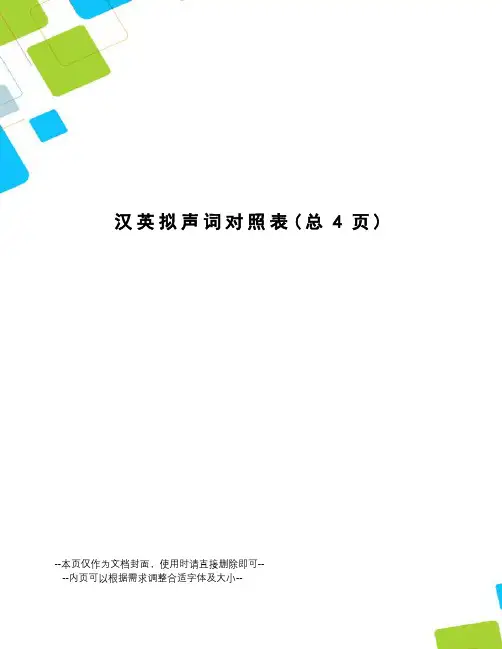
汉英拟声词对照表(总4页)--本页仅作为文档封面,使用时请直接删除即可----内页可以根据需求调整合适字体及大小--汉英拟声词对照表走兽叫声1、狮子(lion): roar, howl;2、老虎(tiger): roar, howl;3、豹子(panther): howl4、大象(elephant): trumpet;5、豺(jackal): howl6 、狼(wolf): howl7、狗(dog): bark,yap,yelp,bay,howl,growl,snarl,whine8、狐(fox): bark,yelp9、猫(cat): mew,miaow,miau,meow,meou10、鼠(mouse): squeak,cheep,peep11、猪(pig): grunt, whick, aqueak12、野猪(swine): grunt13、公猪(boar): girn14、熊(bear): bruzz, growl15、无尾猿(ape): gibber,gueriet16、猴(monkey): screech, gibber, chatter, snutter, jabber, howl17、骆驼(camel): nuzz, grunt18、鹿(deer): call, bell, bellow19、牛(cattle): cow,bleat20、公牛(bull): bellow,low21、母牛(cow): low22、小牛(calf): bleat23、水牛(buffalo): boo24、羊(sheep,goat): baa, bleat25、马(horse): neigh,whinny,nicker26、驴(ass,donkey): bray, hee-haw27、兔子(rabbit): mumble虫子怎么叫,^_^^_^。
虫子声音1、青蛙(frog): croak2、蟾蜍(toad): shriek3、蛇(snake, serpent): hiss4、蜜蜂(bee): buzz,hum,bumble,drone5、黄蜂(wasp): hum6、蟋蟀(cricket): chirp(chirup)7、甲虫(beetle): drone,boom8、蚱蜢(grsshopper): chirp9、蚊子(mosquito): hum,buzz,drone10、苍蝇(fly): hum,buzz,drone飞禽叫声1、公鸡(cock): crow2、母鸡(hen): cackle,cluck3、小鸡(chicken): cheep4、火鸡(turkey): gobble5、鸭(duck): quack6、鹅(goose): cackle,hiss,creak,gaggle7、鸽子(dove,pigeon): coo,crood,croud,croodle,cur8、鹌鹑(quail): curkle9、鸠(stock-dove): murmur10、斑鸠(turtle-dove): wail11、天鹅(swan): chant,cry12、乌鸦(crow,raven): caw,croak13、白嘴鸦(rook): caw14、鹧鸪(partrige): call15、鹦鹉(parrot): prat,squawk16、孔雀(peacock): tantle,scream17、云雀(lark): sing18、红雀(linnet): chirp19、喜鹊(magpie): chatter,clatter20、麻雀(sparrow): chirp21、夜莺(nightingale): warble,pip,jug,jug-jug22、画眉(mavis): guaver23、布谷(cuckoo): cuckoo24、鹤(stork): coniat25、白鹤(crane): whoop26、燕(swallow): chirp,twitter27、海鸥(gull): mew28、鹰(eagle): scream各类物体的响声声音名称响声英文1、金属磕碰声当啷 clank,clang2、形容金属的响声当当 rattle3、金属、瓷器连续撞击声丁零当啷 jingle,jangle,cling-clang4、鼓声、敲门声咚咚 rub-a dub,rat-tat,rat-a-tat5、脆响的(关门)声吧嗒 clik6、敲打木头声梆梆 rat-tat,rat-at7、重物落下声咕咚 thud,splash,plump8、东西倾倒声哗啦 crash,clank9、风吹动树枝叶声飒飒 sough,rustle10、树枝等折断声嘎巴 crack,snap11、不大的寒风声瑟瑟 rustle12、踩沙子、飞沙击物或风吹草木沙沙、飒飒 rustle13、飞机螺旋桨转动呼呼 whirr14、雨点敲击房顶噼里啪啦 patter15、水流动声拔拉 splash,gurgle16、物体受压嘎吱 creak喀嚓17、溪水、泉水流动声潺潺 murmur,babble,purl18、液体、沸腾、水流涌出或大口喝水声咕嘟 babble,gurgle19、重物落地声扑通 flop,thump,splash,pit-a-pat20、笑声、水、气挤出声扑哧 titter,snigger,fizz21、雷声、爆炸声、机器声隆隆 hum,rumble,roll22、汽笛或喇叭声呜呜 toot,hoot,zoom23、油在锅里滋滋 sizzle24、鞭炮爆炸声噼啪 pop25、脚踏楼板声登登 clump拟声词的常见三种翻译处理方法:一、译为汉语对应的拟声词,有的译为独词句,有的译为动词或名词的辅助成分。
汉英拟声词对照表
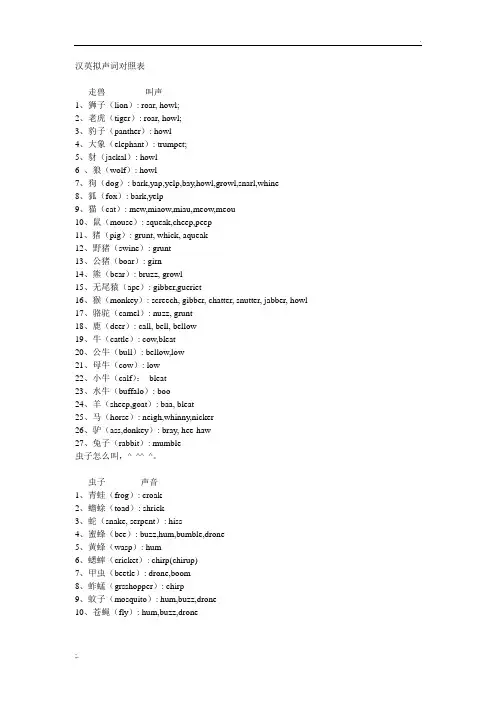
汉英拟声词对照表走兽叫声1、狮子(lion): roar, howl;2、老虎(tiger): roar, howl;3、豹子(panther): howl4、大象(elephant): trumpet;5、豺(jackal): howl6 、狼(wolf): howl7、狗(dog): bark,yap,yelp,bay,howl,growl,snarl,whine8、狐(fox): bark,yelp9、猫(cat): mew,miaow,miau,meow,meou10、鼠(mouse): squeak,cheep,peep11、猪(pig): grunt, whick, aqueak12、野猪(swine): grunt13、公猪(boar): girn14、熊(bear): bruzz, growl15、无尾猿(ape): gibber,gueriet16、猴(monkey): screech, gibber, chatter, snutter, jabber, howl17、骆驼(camel): nuzz, grunt18、鹿(deer): call, bell, bellow19、牛(cattle): cow,bleat20、公牛(bull): bellow,low21、母牛(cow): low22、小牛(calf):bleat23、水牛(buffalo): boo24、羊(sheep,goat): baa, bleat25、马(horse): neigh,whinny,nicker26、驴(ass,donkey): bray, hee-haw27、兔子(rabbit): mumble虫子怎么叫,^_^^_^。
虫子声音1、青蛙(frog): croak2、蟾蜍(toad): shriek3、蛇(snake, serpent): hiss4、蜜蜂(bee): buzz,hum,bumble,drone5、黄蜂(wasp): hum6、蟋蟀(cricket): chirp(chirup)7、甲虫(beetle): drone,boom8、蚱蜢(grsshopper): chirp9、蚊子(mosquito): hum,buzz,drone10、苍蝇(fly): hum,buzz,drone飞禽叫声1、公鸡(cock): crow2、母鸡(hen): cackle,cluck3、小鸡(chicken): cheep4、火鸡(turkey): gobble5、鸭(duck): quack6、鹅(goose): cackle,hiss,creak,gaggle7、鸽子(dove,pigeon): coo,crood,croud,croodle,cur8、鹌鹑(quail): curkle9、鸠(stock-dove): murmur10、斑鸠(turtle-dove): wail11、天鹅(swan): chant,cry12、乌鸦(crow,raven): caw,croak13、白嘴鸦(rook): caw14、鹧鸪(partrige): call15、鹦鹉(parrot): prat,squawk16、孔雀(peacock): tantle,scream17、云雀(lark): sing18、红雀(linnet): chirp19、喜鹊(magpie): chatter,clatter20、麻雀(sparrow): chirp21、夜莺(nightingale): warble,pip,jug,jug-jug22、画眉(mavis): guaver23、布谷(cuckoo): cuckoo24、鹤(stork): coniat25、白鹤(crane): whoop26、燕(swallow): chirp,twitter27、海鸥(gull):mew28、鹰(eagle): scream各类物体的响声声音名称响声英文1、金属磕碰声当啷clank,clang2、形容金属的响声当当rattle3、金属、瓷器连续撞击声丁零当啷jingle,jangle,cling-clang4、鼓声、敲门声咚咚rub-a dub,rat-tat,rat-a-tat5、脆响的(关门)声吧嗒clik6、敲打木头声梆梆rat-tat,rat-at7、重物落下声咕咚thud,splash,plump8、东西倾倒声哗啦crash,clank9、风吹动树枝叶声飒飒sough,rustle10、树枝等折断声嘎巴crack,snap11、不大的寒风声瑟瑟rustle12、踩沙子、飞沙击物或风吹草木沙沙、飒飒rustle13、飞机螺旋桨转动呼呼whirr14、雨点敲击房顶噼里啪啦patter15、水流动声拔拉splash,gurgle16、物体受压嘎吱creak喀嚓crack.snap17、溪水、泉水流动声潺潺murmur,babble,purl18、液体、沸腾、水流涌出或大口喝水声咕嘟babble,gurgle19、重物落地声扑通flop,thump,splash,pit-a-pat20、笑声、水、气挤出声扑哧titter,snigger,fizz21、雷声、爆炸声、机器声隆隆hum,rumble,roll22、汽笛或喇叭声呜呜toot,hoot,zoom23、油在锅里滋滋sizzle24、鞭炮爆炸声噼啪pop25、脚踏楼板声登登clump拟声词的常见三种翻译处理方法:一、译为汉语对应的拟声词,有的译为独词句,有的译为动词或名词的辅助成分。
(完整版)汉英拟声词对照表
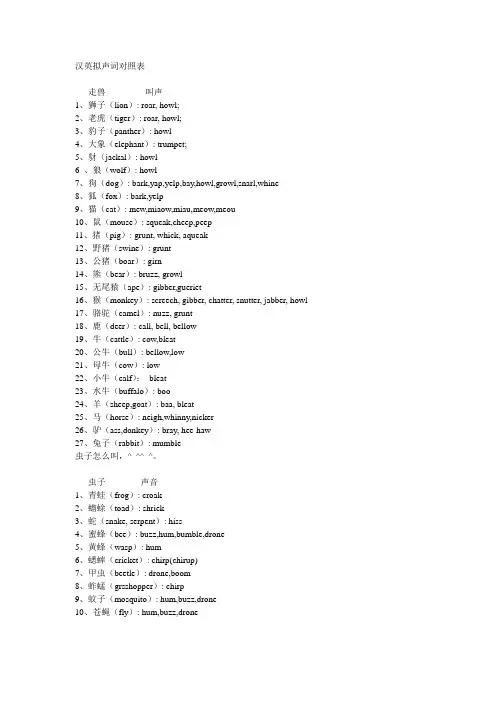
汉英拟声词对照表走兽叫声1、狮子(lion): roar, howl;2、老虎(tiger): roar, howl;3、豹子(panther): howl4、大象(elephant): trumpet;5、豺(jackal): howl6 、狼(wolf): howl7、狗(dog): bark,yap,yelp,bay,howl,growl,snarl,whine8、狐(fox): bark,yelp9、猫(cat): mew,miaow,miau,meow,meou10、鼠(mouse): squeak,cheep,peep11、猪(pig): grunt, whick, aqueak12、野猪(swine): grunt13、公猪(boar): girn14、熊(bear): bruzz, growl15、无尾猿(ape): gibber,gueriet16、猴(monkey): screech, gibber, chatter, snutter, jabber, howl17、骆驼(camel): nuzz, grunt18、鹿(deer): call, bell, bellow19、牛(cattle): cow,bleat20、公牛(bull): bellow,low21、母牛(cow): low22、小牛(calf):bleat23、水牛(buffalo): boo24、羊(sheep,goat): baa, bleat25、马(horse): neigh,whinny,nicker26、驴(ass,donkey): bray, hee-haw27、兔子(rabbit): mumble虫子怎么叫,^_^^_^。
虫子声音1、青蛙(frog): croak2、蟾蜍(toad): shriek3、蛇(snake, serpent): hiss4、蜜蜂(bee): buzz,hum,bumble,drone5、黄蜂(wasp): hum6、蟋蟀(cricket): chirp(chirup)7、甲虫(beetle): drone,boom8、蚱蜢(grsshopper): chirp9、蚊子(mosquito): hum,buzz,drone10、苍蝇(fly): hum,buzz,drone飞禽叫声1、公鸡(cock): crow2、母鸡(hen): cackle,cluck3、小鸡(chicken): cheep4、火鸡(turkey): gobble5、鸭(duck): quack6、鹅(goose): cackle,hiss,creak,gaggle7、鸽子(dove,pigeon): coo,crood,croud,croodle,cur8、鹌鹑(quail): curkle9、鸠(stock-dove): murmur10、斑鸠(turtle-dove): wail11、天鹅(swan): chant,cry12、乌鸦(crow,raven): caw,croak13、白嘴鸦(rook): caw14、鹧鸪(partrige): call15、鹦鹉(parrot): prat,squawk16、孔雀(peacock): tantle,scream17、云雀(lark): sing18、红雀(linnet): chirp19、喜鹊(magpie): chatter,clatter20、麻雀(sparrow): chirp21、夜莺(nightingale): warble,pip,jug,jug-jug22、画眉(mavis): guaver23、布谷(cuckoo): cuckoo24、鹤(stork): coniat25、白鹤(crane): whoop26、燕(swallow): chirp,twitter27、海鸥(gull):mew28、鹰(eagle): scream各类物体的响声声音名称响声英文1、金属磕碰声当啷clank,clang2、形容金属的响声当当rattle3、金属、瓷器连续撞击声丁零当啷jingle,jangle,cling-clang4、鼓声、敲门声咚咚rub-a dub,rat-tat,rat-a-tat5、脆响的(关门)声吧嗒clik6、敲打木头声梆梆rat-tat,rat-at7、重物落下声咕咚thud,splash,plump8、东西倾倒声哗啦crash,clank9、风吹动树枝叶声飒飒sough,rustle10、树枝等折断声嘎巴crack,snap11、不大的寒风声瑟瑟rustle12、踩沙子、飞沙击物或风吹草木沙沙、飒飒rustle13、飞机螺旋桨转动呼呼whirr14、雨点敲击房顶噼里啪啦patter15、水流动声拔拉splash,gurgle16、物体受压嘎吱creak喀嚓crack.snap17、溪水、泉水流动声潺潺murmur,babble,purl18、液体、沸腾、水流涌出或大口喝水声咕嘟babble,gurgle19、重物落地声扑通flop,thump,splash,pit-a-pat20、笑声、水、气挤出声扑哧titter,snigger,fizz21、雷声、爆炸声、机器声隆隆hum,rumble,roll22、汽笛或喇叭声呜呜toot,hoot,zoom23、油在锅里滋滋sizzle24、鞭炮爆炸声噼啪pop25、脚踏楼板声登登clump拟声词的常见三种翻译处理方法:一、译为汉语对应的拟声词,有的译为独词句,有的译为动词或名词的辅助成分。
动物的“叫”声象声词中英文对照
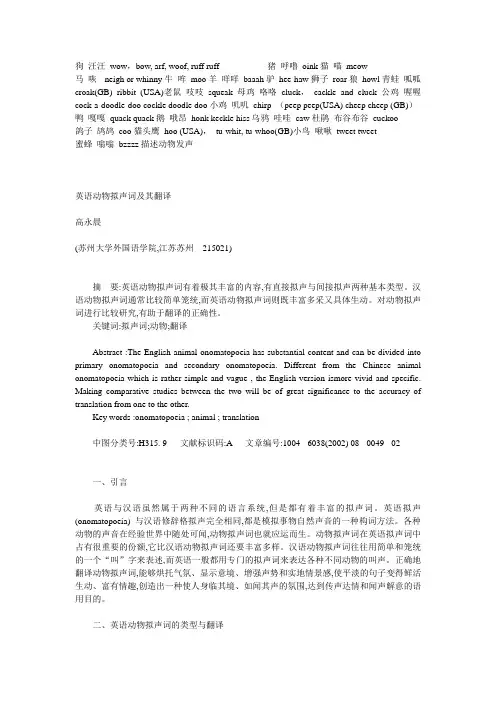
狗汪汪wow,bow, arf, woof, ruff ruff 猪呼噜oink猫喵meow马咴-- neigh or whinny牛哞moo羊咩咩baaah驴hee-haw狮子roar狼howl青蛙呱呱croak(GB) ribbit (USA)老鼠吱吱squeak母鸡咯咯cluck,cackle and cluck公鸡喔喔cock-a-doodle-doo cockle doodle doo小鸡叽叽chirp (peep peep(USA) cheep cheep (GB))鸭嘎嘎quack quack鹅哦昂honk keckle hiss乌鸦哇哇caw杜鹃布谷布谷cuckoo鸽子鸪鸪coo猫头鹰hoo (USA),tu-whit, tu-whoo(GB)小鸟啾啾tweet tweet蜜蜂嗡嗡bzzzz描述动物发声英语动物拟声词及其翻译高永晨(苏州大学外国语学院,江苏苏州215021)摘要:英语动物拟声词有着极其丰富的内容,有直接拟声与间接拟声两种基本类型。
汉语动物拟声词通常比较简单笼统,而英语动物拟声词则既丰富多采又具体生动。
对动物拟声词进行比较研究,有助于翻译的正确性。
关键词:拟声词;动物;翻译Abstract :The English animal onomatopoeia has substantial content and can be divided into primary onomatopoeia and secondary onomatopoeia. Different from the Chinese animal onomatopoeia which is rather simple and vague , the English version ismore vivid and specific. Making comparative studies between the two will be of great significance to the accuracy of translation from one to the other.Key words :onomatopoeia ; animal ; translation中图分类号:H315. 9 文献标识码:A 文章编号:1004 - 6038(2002) 08 - 0049 - 02一、引言英语与汉语虽然属于两种不同的语言系统,但是都有着丰富的拟声词。
英汉拟声词的比较与翻译探析
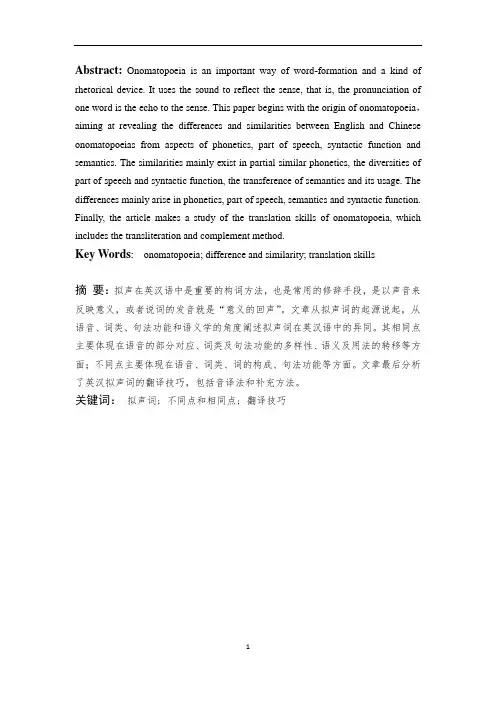
Abstract:Onomatopoeia is an important way of word-formation and a kind of rhetorical device. It uses the sound to reflect the sense, that is, the pronunciation of one word is the echo to the sense. This paper begins with the origin of onomatopoeia,aiming at revealing the differences and similarities between English and Chinese onomatopoeias from aspects of phonetics, part of speech, syntactic function and semantics. The similarities mainly exist in partial similar phonetics, the diversities of part of speech and syntactic function, the transference of semantics and its usage. The differences mainly arise in phonetics, part of speech, semantics and syntactic function. Finally, the article makes a study of the translation skills of onomatopoeia, which includes the transliteration and complement method.Key Words: onomatopoeia; difference and similarity; translation skills摘要:拟声在英汉语中是重要的构词方法,也是常用的修辞手段,是以声音来反映意义,或者说词的发音就是“意义的回声”。
汉英翻译声音颜色词的翻译

LOGO
如4. 颜色词的翻译 翻译颜色词要首先准确理解其意义、特别是其所承载的文化内 涵,弄清其语法功能和篇章功能,然后根据不同的情况选择不同 的翻译方法。一般来说颜色词的翻译方法有以下四种:译成相对 应的颜色词、译成不对应的颜色词、译出比喻义和引申义、原文 没有颜色词翻译时增补颜色词等。 英译汉例句: 1) She was wearing a dark red blouse, the rolled-up sleeves revealing the snow of her arms. 她穿着一件深红色的罩衫,卷起的袖子下露出雪白的 胳膊。 22 2) Variously viewed, the ducks change subtly in colour from ruby to yellow to violet.
鸭子身上的颜色因人们观察角度的变换而发生微妙的变 化:忽红、忽黄、忽紫。
LOGO
如 3)My finger was caught in the crack of the door and got pinched black and blue. 我的手指夹在门缝里,挤压得又青又紫。 4)He went purple with rage. 他气得脸色铁青。 5)The maxim was that when a married couple saw red lawyers saw green. 俗话说,夫妻吵得面红耳赤之时,正是律师招财进宝 之时。
LOGO
英汉互译
拟声词是以模仿动作事物的声音构成的词。它的所指意 义是模仿的声音,语用意义是该词的修辞效果。声音词的突出功 能是美感功能,使语言生动鲜明,绘声绘色,增加艺术效果。由 于词语构成及声音象征性的差异,翻译时要酌情调整。 1. 英汉拟声词比较 A 同一声音在英汉语言中用相同的拟声词来表达: pat 啪(轻拍声) giggle----咯咯(地笑) meow/miaow/miaou/meau -----喵(猫叫声) cuckoo-----咕咕(杜鹃叫声) howl----狼嚎 moo---- 哞哞 B 同一个声音在英语和汉语中用不同的拟声词来表达 cock-a-doodle-do --------喔喔叫(公鸡鸣) croak------咕咕、呱呱(蛙鸣) drum---咚咚(鼓声) whiz----嗖嗖(子弹呼啸声) clang----铿锵(金属碰击声) crack----噼啪(爆裂声) bleat---咩咩(羊叫声)
拟声词中英文对照版(全)
走兽怎么叫: 1、 狮子(lion) 2、 老虎(tiger) 3、 豹子(panther) 4、 大象(elephant) 5、 豺(jackal) 6、 狼(wolf) 7、 狗(dog) 8、 狐(fox) 9、 猫(cat) 10、 鼠(mouse) 11、 猪(pig) 12、 野猪(swine) 13、 公猪(boar) 14、 熊(bear) 15、 无尾猿(ape) 16、 猴(monkey) 17、 骆驼(camel) 18、 鹿(deer) 19、 公牛Bulls,Oxes 20、 母牛Cows 21、 牛(cattle) 22、 小牛(calf) 23、 水牛(buffalo) 24、 马(horse) 25、 驴(ass,donkey) 26、 兔子(rabbit) 27、 犀牛(Rhinos) 28、 猴“叽哩呱啦”(Monkeys,Apes) 29、 袋鼠(Kangaroos) 30、 松鼠(Squirrels) 31、 老鼠“吱吱”(Rats,Mouses) 32、 猫(Cats) 33、 狗(Dogs) 34、 绵羊(Sheep) 35、 山羊(Goats) 36、 小羊(Lambs) 37、 猪哼哼(Pigs,Hogs,Swines) 38、 公猪吼(Boars) 39、 驴(Asses,Donkeys) 40、 公牛(Bulls,Oxes) 41、 母牛(Cows) 42、 考拉(Koalas) 43、 獾(Badgers) 44、 鬣狗(Hyena) 45、 熊(Bears) 46、 浣熊(Raccoons) 47、 龟(Tortoises,Turtles) 48、 鸭嘴兽(Platypuses)
拟声词的英汉对比
C. 模拟大千世界的声音 zip——嗖嗖(子弹声) crack——劈啪(爆裂声) rustle——飒飒(风声) rumble——隆隆(雷声) clink——叮当(碰杯声)
语符号具有任意性 音系结构 词汇形态 使用习惯 模拟
某一自然声音并非只有一个拟声词, 某一自然声音并非只有一个拟声词, 某一拟声词并非只描摹一个声响
3、语义转移路径的差异性 、
•英语由拟声转向“发音体”和“动作”,汉语由拟声转向“性质”和“状态” 英语由拟声转向“发音体” 英语由拟声转向 动作” 汉语由拟声转向“性质” 状态”
baa—baa choochoo bubble splash crash clash crack
sheep 火车头 转喻性 指“水泡”或“气泡” 溅起的水或泥浆 “失败”或“垮台” “抵触”或“冲突” “缺点” 隐喻性
meow [mi'ao] 喵
2.2 差异很大的英汉拟声词
B. 模拟动物的声音 A. 模拟人类声音 bleat boo cluck ouch croak snore chirp chortle chatter titter 呸(表示嫌恶或轻蔑) 咩咩叫 咯咯叫 哎哟(突然受痛时的叫喊声) 呱呱叫 呼噜声(打鼾时) 唧唧叫 哈哈大笑声 嗤嗤的笑声 喳喳叫
bang “热情” “精力” “刺激” “快感” 轰轰烈烈、大大咧咧、慢慢腾腾、乱乱哄哄、轰然、哄然、怦然
1.2 汉语拟声词重叠形式比英语更为丰富
•英汉拟声词语音结构对比表 英汉拟声词语音结构对比表
•英汉拟声词的语音结构具体可归纳为以下 种 英汉拟声词的语音结构具体可归纳为以下13种 英汉拟声词的语音结构具体可归纳为以下
A,AA,AB,ABB,AAB,AAA,AXB,ABCB, ABBB,AABB,ABCD,AXBC,AXACt
中英拟声词介绍
中英拟声词介绍A cat miaows /mews/purrs.猫"喵喵"叫。
狗bark. bark除了有"犬吠"的意思外,还有"树皮"的意思。
另外还有yap(汪汪叫)想一下不停的狗吠是不是很招人烦,所以yap这个词另外的意思就是"吵嚷"。
另外yelp 和snarl也是常用来形容狗叫的。
A dog yaps/ yelps/ barks/ snarls.狗吠。
quack这个词除了用来形容鸭子叫之外还可以用来指"江湖医生,庸医。
"记住了这个quack害人真是不浅呀。
A cock crows.公鸡啼。
这个crow的意义可非同一般,"公鸡啼鸣"它表示新的一天又开始了。
还记得红楼梦里薛蟠哼的那首打油诗吗?"一个苍蝇嗡啊嗡,一个蚊子哼啊哼。
"它们的声音听起来真是令人讨厌。
英语里又是用什么词来形容它们的声音呢?只要这两个词就可以了:buzz(嗡嗡)hum(哼哼) A fly hums/ buzzes/ drones.苍蝇"嗡嗡"叫。
A bee/ mosquito hums/ buzzes.蜂/蚊子"嗡嗡"叫。
这里hum除了尤指蜜蜂发"嗡嗡"(a continuous buzz)声,发"哼哼"声外,还可以用来指人等"闭嘴哼唱",如:hum a song 哼一首歌。
A chick cheeps/ pips/ pules/ peeps.小鸡"叽叽"叫。
A bird/ sparrow twitters /chirps/ chirrups.鸟/麻雀"唧唧喳喳"叫。
A rat squeaks.耗子"唧唧"叫。
A calf/lamb/goat bleats.小牛/小羊/山羊叫。
中英文拟声词翻译对比
中英文拟声词翻译对比中英文拟声词翻译对比王秀,陈倩(兰州理工大学外国语学院,甘肃兰州730050)摘要:本文就中英文两种语言的拟声词翻译做了对比,即英文拟声词的汉译以及汉语拟声词的英译。
由于汉语里一般采用直接摹写声音的拟声词,而在英语里一些动词和名词本身就具备了拟声的特点,融音与意为一体,引起音与音之间的联想。
因此本文论述了拟声词在翻译时需要考虑的这些差异和两种语言互译时对拟声词的处理方法。
关键词:拟声词;翻译;对比1. 引言把人、动物或自然物所发出的声音如实地加以描摹,这种修辞方法称为拟声。
汉英皆有,但是有着较大的区别。
在汉语里一般采用直接摹写声音的拟声词,而在英语里,一些动词和名词本身就具备了拟声的特点,融音与意为一体,引起音与音之间的联想。
因此拟声词的翻译需要考虑这些差异,本文就英文拟声词的汉译与汉语拟声词的英译做简单论述。
2. 英文拟声词的汉译2.1 英文中的拟声词可以直接翻译为汉语拟声词e.g.(1) The sweet trilling of a murmuring stream and the melodious notes of nightingales formed altogether the most enchanting harmony.悦耳的潺潺流水和夜莺的婉转娇啼,奏出令人神往的和谐曲调。
(2) All you can do is keep on clack-clack-clacking.你老是叨叨叨,叨叨叨。
2.1.1 英语拟声词往往同感叹词一样,独立使用,不作为所在句中的任何句法成分。
汉语拟声词有同样的情况,因此汉译时较为简便,把英语原文中作独立成分用的拟声词相应地译成汉语中作独立成分的拟声词即可。
e.g. (1) She drew one out. R-r-atch! How it sputtered and burned.(Hans Christian Anderson: The little match girl!)她抽出一根火柴,哧!啪一下子燃着了。
- 1、下载文档前请自行甄别文档内容的完整性,平台不提供额外的编辑、内容补充、找答案等附加服务。
- 2、"仅部分预览"的文档,不可在线预览部分如存在完整性等问题,可反馈申请退款(可完整预览的文档不适用该条件!)。
- 3、如文档侵犯您的权益,请联系客服反馈,我们会尽快为您处理(人工客服工作时间:9:00-18:30)。
中英文拟声词翻译对比王 秀,陈 倩 (兰州理工大学外国语学院,甘肃兰州 730050) 摘 要:本文就中英文两种语言的拟声词翻译做了对比,即英文拟声词的汉译以及汉语拟声词的英译。
由于汉语里一般采用直接摹写声音的拟声词,而在英语里一些动词和名词本身就具备了拟声的特点,融音与意为一体,引起音与音之间的联想。
因此本文论述了拟声词在翻译时需要考虑的这些差异和两种语言互译时对拟声词的处理方法。
关键词:拟声词;翻译;对比 1. 引言把人、动物或自然物所发出的声音如实地加以描摹,这种修辞方法称为拟声。
汉英皆有,但是有着较大的区别。
在汉语里一般采用直接摹写声音的拟声词,而在英语里,一些动词和名词本身就具备了拟声的特点,融音与意为一体,引起音与音之间的联想。
因此拟声词的翻译需要考虑这些差异,本文就英文拟声词的汉译与汉语拟声词的英译做简单论述。
2. 英文拟声词的汉译2.1 英文中的拟声词可以直接翻译为汉语拟声词e.g.(1) The sweet trilling of a murmuring stream and the melodious notes of nightingales formed altogether the most enchanting harmony.悦耳的潺潺流水和夜莺的婉转娇啼,奏出令人神往的和谐曲调。
(2) All you can do is keep on clack-clack-clacking.你老是叨叨叨,叨叨叨。
2.1.1 英语拟声词往往同感叹词一样,独立使用,不作为所在句中的任何句法成分。
汉语拟声词有同样的情况,因此汉译时较为简便,把英语原文中作独立成分用的拟声词相应地译成汉语中作独立成分的拟声词即可。
e.g. (1) She drew one out. R-r-atch! How it sputtered and burned.(Hans Christian Anderson: The little match girl!)她抽出一根火柴,哧!啪一下子燃着了。
(2) Thump! A table was overturned!“哗啦!”桌子推翻了。
(3) Two heavy guns went off in the woods—Bump! Bump!两门重炮在森林里开始发射了——轰隆!轰隆!2.1.2 英文中的拟声词通常是动词、名词或者动词派生词(分词、不定式、动名词),而汉语的拟声词通常是动词或者名词的附加成分。
因此,英文中拟声的动词、名词和动词派生词在汉语中常常被翻译成动【作者简介】 王秀(1971-),女,硕士,兰州理工大学外国语学院讲师;研究方向:外国语言学与应用语言学。
陈倩(1977-),女,兰州理工大学外国语学院讲师;研究方向:外国语言学与应用语言学。
59词和名词的附加成分。
e.g.(1) But as the door banged, she seemed to come back to life again.可是当门砰地一声关上地时候,她好像又清醒过来了。
(动词附加成分)(2) All was quiet and still except for the distant tinkling of a piano.除了远处一架钢琴地叮当叮当声之外,万籁俱寂。
(名词附加成分)(3) “What’s happening?”he muttered.“怎么回事呀?”他喃喃地问。
(动词附加成分)(4) They heard the twitter of birds among the bushes.他们听到树丛中鸟儿发出的嘁嘁喳喳声。
(名词附加成分)(5) All the time there were clucks of admiration from the crowds.人们时时发出“啧,啧”的赞叹声。
(名词附加成分)2.1.3英文中的某些拟声词可以模仿不同事物的声音,在汉语中要翻译为不同的拟声词。
e.g. (1) Thunder rumbled in the distance.远处雷声隆隆。
(2) The cart rumbled past.大车轱辘轱辘地驶过。
(3) His stomach rumbled emptily.他的肚子饿得咕咕叫。
2.2 有些英文拟声词在翻译为汉语时不必译为拟声词在英译汉时,原文中的拟声词并不是在任何情况下都必须在译文中加以机械复制。
拟声词的运用必须有利、有节。
不论写作与翻译,都不宜毫不节制地滥用拟声词,以免文字流于轻佻、累赘,降低表达力。
译者有时斟酌上下文的情况,可以运用非拟声词来表达英语拟声词。
2.2.1 在英文中为了表达地更加形象,各种非生物的声音在英语中很多是由专词表达的,在翻译为汉语时通常译为“……声”、“……响”,不附加任何拟声词,如“脚步声”、“飞机声”、“电话响了”等。
e.g. (1) We heard the machine whir.我们听到了机器声。
(2) The squeaking of the radio was disturbing everybody.收音机的声音在扰乱大家。
(3) The screeching of the breaks got on my nerves.刹车声刺激我的神经。
(4) The train whistle tooted.火车汽笛响了。
(5) The underground train was humming.地铁在响。
2.2.2 英语中一般都用专门拟声词表达各种动物的叫声,汉语以前也有专词表达如:狗吠。
但在近代汉语中,尤其在口语中,这些专词已不常用。
因此在汉译时被翻译为“……叫”、“……鸣”。
e.g. (1) The moment he rushed in, the hens chucked and the dogs barked.他一进门,鸡也鸣,狗也叫。
(2) The frogs in the fields outside the town were croaking cheerfully.青蛙在城郊的田野里气紧地叫着。
2.2.3 其它e.g. (1) He slammed his tea cup down on the table.他把茶杯往桌上一顿。
(2) The cop carried a stick, ready to thwack anybody who offended his car or eye.60警察提了根棍棒,遇到他不顺眼的,不顺耳的,动手就打。
2.3 英文中的非拟声词可以翻译为汉语中的拟声词e.g.(1) The kids are crying loudly.孩子们在哇哇大哭。
(2) Phyl expected them to start brawling, but Mrs. Cooper merely laughed good-naturedly.菲儿以为他们要开始吵架了,可是库柏太太只是很和善的哈哈大笑了一阵。
(3) …I was born (as I have been informed and believe) on a Friday, at twelve o’clock at night. It was remarked that the clock began to strike, and I began to cry, simultaneously.(Dickens: David Copperfield) 我生在一个星期五的夜里十二点钟。
别人这样告诉我,我也这样相信。
据说,座钟当当一响,不早不晚,我就呱呱坠地。
3. 汉语拟声词的英译在汉译英时拟声词可以有一下几种处理方法:3.1 在译文中保持原拟声词的此类属性及其在句子里的成分e.g. (1) 啪!——一声响,那枝象牙烟枪断成两截。
(茅盾:《子夜》)Crack! ... the long ivory opium-pipe in two. (独立成分)(2)哈哈哈,这不要紧。
Ha! Ha! Ha!What does it matter? (独立成分)(3) 一个蚊子哼哼哼。
两个苍蝇嗡嗡翁。
(曹雪芹:《红楼梦》)A mosquito Hums and Hums.Two flies drone and drone.(谓语)(4) 车辚辚,马萧萧。
(杜甫:《兵车行》)Chariots rumble and roll; horses whinny and neigh.(谓语)(5) 杯筷陈设在个人面前,暖锅里发出滋滋的有味的声音。
(叶圣陶:《倪焕之》)Wines-cups and chopsticks were laid out, and a delicious sizzling sound came from the chafing dish.3.2 在译文中转换原拟声词的词类属性及其在句子里成分e.g. (1)登!登!登!一阵楼梯板响,匪徒们上楼了。
(陶承:《我的一家》)Then followed a loud Clump! Clump! Clump!as they rushed up the stairs.(2) 正中的门呀地一声开了一半。
(曹禺:《日出》)The center door creaks half-open.(3) 隔壁牢房的铁锁响了一声,接着,传来推开铁门的哗啦啦的巨响。
(罗广斌《红岩》)A lock rattled and there was a loud clank as the door of the next cell was flung open.(4) 北风吹得呼呼的。
A north wind is whistling.3.3 汉语中用拟声词,英译时可以不用拟声词e.g.(1) 在喀嚓喀嚓的铡刀声中,听到了死难者英勇的呼叫声“共产党万岁!乡亲们……报仇。
”(曲波:《林海雪原》)Even as the chaff cutter did its grisly work, the last shouts of the victims rang out:“Long live the Communist Party! Folks, Revenge….”(2) 那老头在吧嗒吧哒地抽着一个烟袋。
That old man was sucking vigorously at a pipe.61(3) 我闻琵琶已叹息,又闻此语重唧唧。
(白居易:《琵琶行》)I had sighed when I first heard the lute, and now I heard her story which made lament.3.4 汉语中不用拟声词,英译时可以用拟声词e.g. (1) 她笑着说:“眉,下边马路上有人看你!”She tittered and exclaimed, “Mei, somebody down in the street is looking up you!”(2) 觉来盼前庭,一鸟花间鸣。
